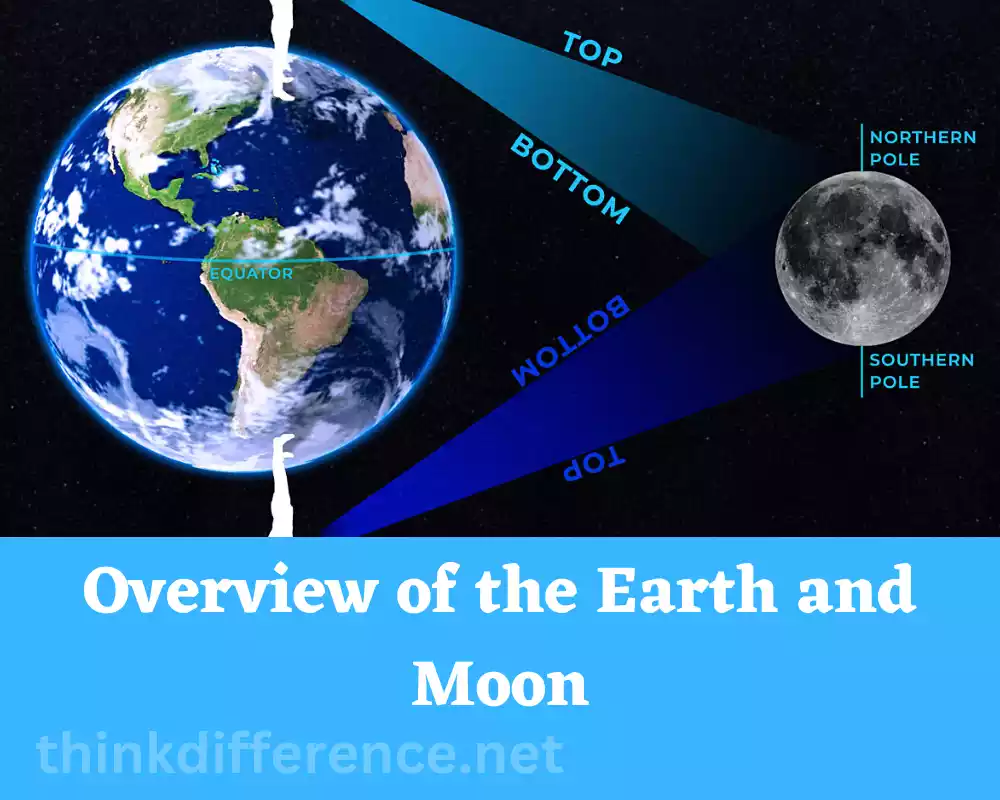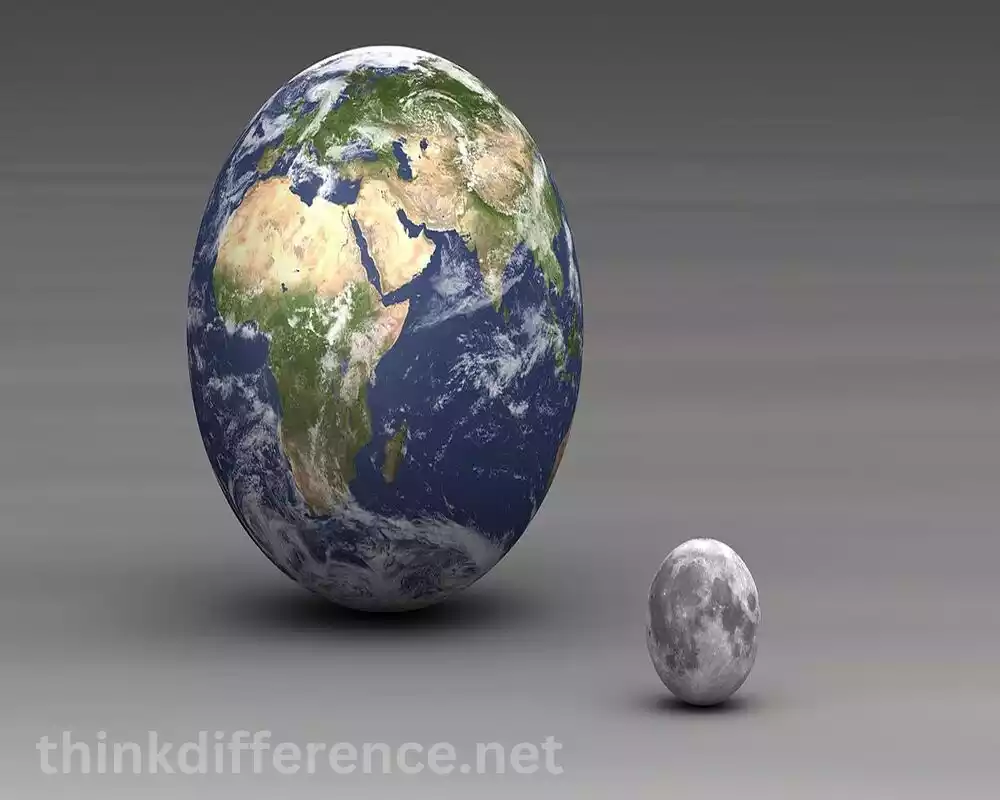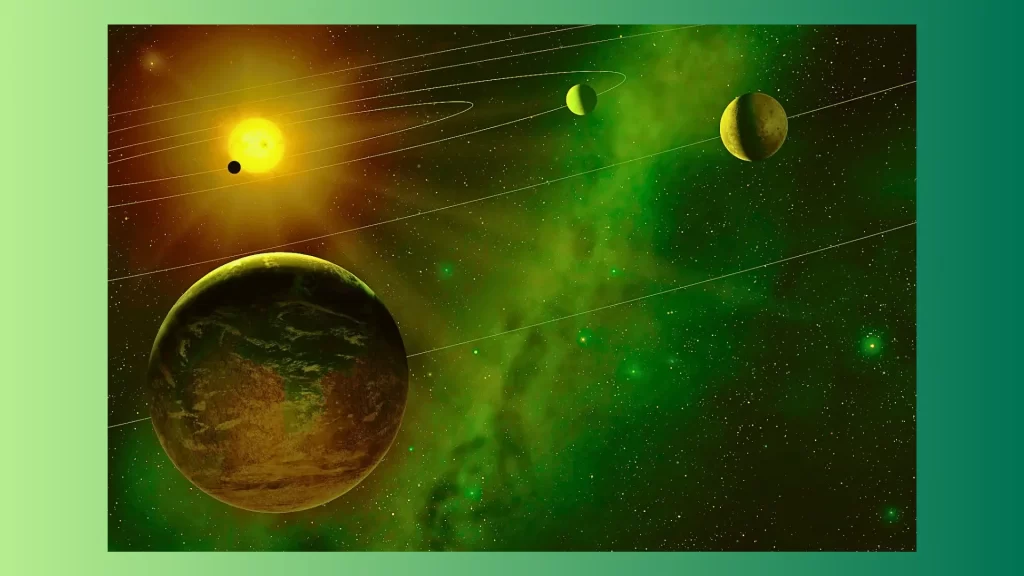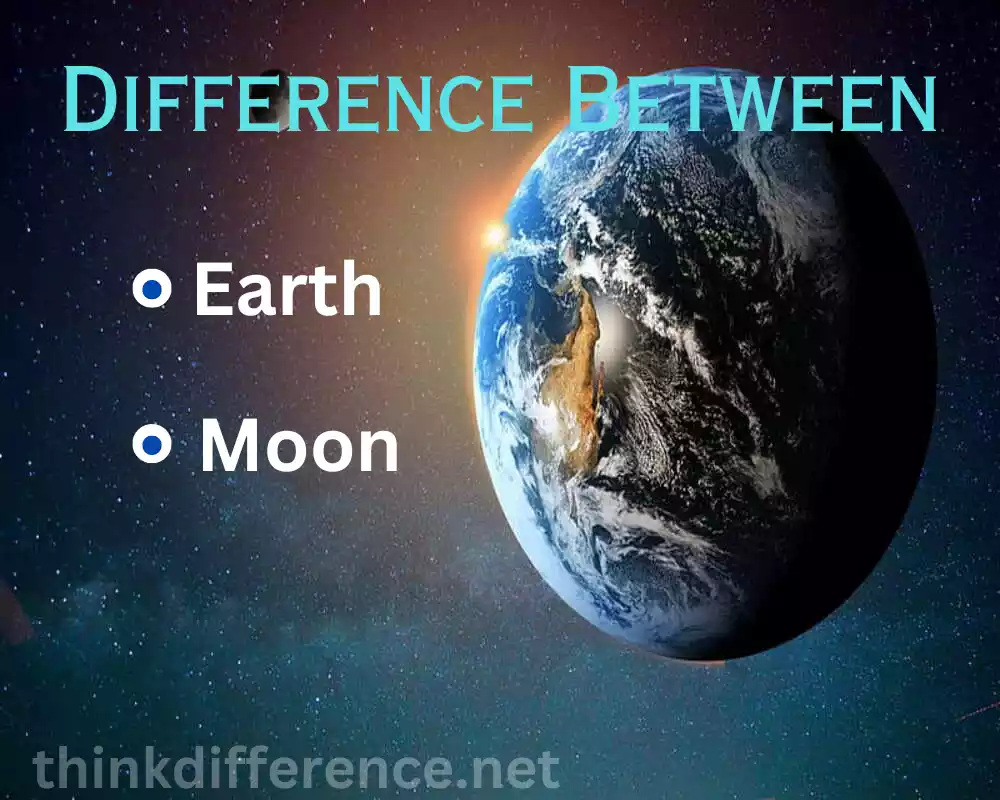The Earth and the Moon are celestial bodies that have captivated human curiosity for centuries. As our closest neighbourhood in space and beyond, the Moon provides endless sources of fascination, wonder and inspiration – while Earth provides our home and daily needs. In this article we’ll look into their structures, formation and distinctive particularities for both planets as well as how their interconnection and significance contributes to cosmic tapestries.
An Overview of the Earth and Moon
Both Earth and Moon hold great symbolic value to us humans as cosmic bodies in general, providing insight into its inner workings and evolution.

Earth:
Earth is known as the third planet from our Sun and, with an abundance of water resources found here, is often called “Blue Planet.” Being life’s sole home planet, its surface measures around 12,742 kilometers (7,918 miles). And its mass approximately 5.971024 kg. Earth consists of many layers, such as its crust, mantle, outer core and inner core.
Its atmosphere contains oxygen, nitrogen and trace gases which promote diverse ecosystems while controlling climate conditions. Earth is subject to tectonic activity along its plates, leading to volcanic eruptions, earthquakes and mountain range formation. Our planet features oceans and continents which offer various habitats and geographical features for our survival.
Moon:
The Moon is our primary satellite and fifth largest moon that orbits around our sun. It orbits at approximately 384,400 kilometers (238,900 miles). Its size and mass is smaller than Earth. It lacks a significant atmosphere and bodies of water. The Moon’s surface is characterized by vast regions of gray-colored plains known as “Maria” and numerous impact craters.
The absence of erosion and weather conditions on the Moon has preserved the craters, making it an important site for studying the history of impacts in the solar system. The Moon’s lack of an atmosphere also leads to extreme temperature variations between its day and night sides.
Understanding Earth and Moon gives insight into their formation, climate change and potential life within this universe. Exploring these celestial bodies through missions and research enhances our knowledge of our own planet as well as the broader field of space science.
Importance of understanding the Earth and Moon
Understanding the Earth and Moon holds significant importance for various reasons. Here are some key reasons why studying these celestial bodies is crucial:
- Planetary Formation: Paying attention to what happens with Earth and Moon can provide researchers with an idea of the process behind their creation, satellites and planets. By studying their compositions structures histories as well as mechanisms, scientists will gain more of an insight into our solar system’s creation process and why specific objects came about.
- Earth as a Habitable Planet: Earth is unique among planets because of its ability to support life. By studying its various features – climate, atmosphere and geology – scientists learn more about what conditions must exist to foster growth and development of organisms, helping discover life elsewhere in space.
- Climate Dynamics: Earth’s climate is an intricate system influenced by numerous variables including ocean currents, the atmosphere and land surfaces – as well as human activities – all which play a part. Understanding patterns of Earth’s climate changes are vitally important in forecasting effects from global climate shifts as well as developing sustainable solutions and protecting future generations of life on our planet.
- Geological Processes: Earth’s geologic processes like plate tectonics, volcanic activity and erosion have significantly modified its surface over the millennia. Understanding these processes enables us to recognize valleys, mountains, oceans and other geological characteristics from these changes over time; and may allow us to anticipate natural disasters like earthquakes or volcanic eruptions so as to take steps necessary for safety of lives and infrastructure.
- Lunar History and Space Exploration: The Moon serves as a time capsule, recording both our solar system’s history as a whole as well as celestial bodies’ interactions. By studying lunar material and surface features scientists gain an insight into early Earth-Moon axis development as well as an understanding of solar system evolution. Space exploration plans include long-term human presence on its surface so as to permit ongoing scientific studies and missions exploring other places on our solar system’s orbital plane.
- Technology and Innovation: The exploration and study of space places enormous strains on technological and scientific innovations. Satellite missions to space, observations and related research help fuel advancements in robotics, aerospace engineering materials science remote sensing technology that have far reaching implications beyond space exploration: in industries, communications networks as well as daily activities on Earth.
As our knowledge of Earth and Moon increases, so too do our understandings of space explorations and discoveries. Sustainability efforts for environmental improvement improve, leading to new practices established as sustainable practices paving way for explorations in space and discoveries yet untold.
Formation and Composition
Formation and composition play a crucial role in understanding the Earth and Moon. Here is formation and composition:
Formation of the Earth:
The current prevailing theory of Earth’s formation is the nebular hypothesis. Based on this theory, approximately 4.6 billion years ago the massive cloud of dust and gas known as the solar nebula collapsed under its gravity’s force. As the collapse occurred, the central region formed the Sun, while the remaining material in the outer disk coalesced to form protoplanetary bodies, including the Earth.
During the early stages of its formation, the Earth experienced intense heating and differentiation. Heavier elements sank towards the center, forming the core, primarily composed of iron and nickel. Lighter materials, such as silicates, formed the mantle surrounding the core. The crust, composed of various rock types, formed on the outermost layer.
Formation of the Moon:
It is generally believed that the Moon formed due to an enormous impact, known as “giant impact hypothesis” or the “Big Splash.” According to this theory, mars-sized body Theia collided with young Earth, sending particles flying off into space. Over time, this debris coalesced to form the Moon.
The impact was immensely violent and caused intense heating and melting. Heat generated by this collision resulted in the formation of an immense “lunar magma ocean.” Eventually, this magma ocean solidified, giving rise to the Moon’s distinct layers and surface features.
Composition of the Earth:
The Earth consists of many distinct layers with diverse compositions. At its surface lies silicon aluminum calcium iron potassium. Subterranean mantle contains predominantly silicate minerals with high magnesium iron levels while finally at the core lies nickel iron which make up its predominant elemental constituents.
Earth is home to vast amounts of water, mostly contained within oceans. Its atmosphere contains oxygen, nitrogen and carbon dioxide among various other gases – among others.
Composition of the Moon:
The Moon differs significantly from Earth in composition; its surface, known as regolith, contains dust particles, stones and small fragments rich in silicon, oxygen and magnesium as well as calcium, iron and even small levels of hydrogen titanium and helium compared to Earth.
The lunar interior consists of rocks similar to those found on Earth, although with smaller quantities of volatile elements like water. A low-level atmosphere also separates it from our planet.
Understanding Earth and Moon structures provides us with insight into their formation processes as well as understanding their unique features and behavior.
Size and Structure
Size and structure are important aspects when comparing the Earth and the Moon.

Here is an overview of their size and structure:
Earth:
Size:
- Diameter: Earth boasts an approximate diameter of 12742 km (7,918 miles), making it one of the five-largest planets in our solar system.
- Mass: The Earth boasts an estimated mass of 5.97 1024 kilograms and thus stands as one of the four planets within our solar system.
- Volume: The Earth has a volume of approximately 1.08 × 10^12 cubic kilometers.
Structure:
- Layers: The Earth consists of many distinct layers.
- Crust: The outermost layer ranging in thickness between 5 and 70 km (3 or 44 miles). Composed primarily of solid rocks.
- Mantle: The layer beneath the crust, extending to a depth of about 2,900 kilometers (1,800 miles), composed of solid but pliable rock.
- Outer Core: The liquid layer surrounding the solid inner core, with a thickness of approximately 2,300 kilometers (1,400 miles). It is primarily composed of molten iron and nickel.
- Inner Core: The solid innermost layer, with a radius of about 1,220 kilometers (760 miles). It consists primarily of solid iron and nickel.
Moon:
Size:
- Diameter: At approximately 3,474 km (2,159 miles), Moon has approximately one-quarter the diameter of Earth.
- Mass: 7.341022 kilograms The Moon weighs 7,341022 kilograms – about one eighth as much as its Earth counterpart.
- Volume: The Moon covers an approximate surface area of 2.20 1010 cubic km – or roughly 22% of that found on Earth.
Structure:
- Layers: The Moon does not have distinct layers like the Earth.
- Crust: The Moon’s outermost layer is the crust, composed of rocks, dust, and regolith. Thicker layers on either side may range anywhere between 30 km (19 miles) to as much as 60 km (37 miles), depending on its depth and location.
- Mantle: The substratum below Earth’s crust known as the mantle extends for approximately 1,000 kilometers (622 miles).It consists of solid rock, similar to the Earth’s mantle.
- Core: The Moon is believed to have a small core, possibly molten, but its size and composition are not precisely known.
Comparing the Earth and the Moon’s size and structure highlights their differences. The Earth is significantly larger, with a more complex internal structure, including distinct layers and a substantial core. The Moon is smaller, lacks distinct layers like the Earth, and has a less developed core.
Understanding these differences is crucial for comprehending the unique characteristics and behaviors of these celestial bodies.
Orbital Characteristics and Motions
The Earth and Moon have distinct orbital characteristics and motions. Here is an overview of their orbital characteristics:
Earth’s Orbit around the Sun:
- Distance: The Earth and Sun are approximately separated by approximately 149.6 million km or 93 million miles – commonly referred to as one astronomical unit or “AU.”
- Elliptical Orbit: Earth follows an elliptical orbit around Sun with Sun situated within any of its points on an ellipse, creating frequent variations in their distance from one another throughout the year. Earth comes closest (perihelion) on January 3, roughly 91.4 Million Miles away compared with July 4th when its furthest distance (aphelion) from its Sun is reached; perigee occurs around this date too (91 Million miles).
- Axial Tilt: The Earth’s axis is tilted at 23.5 degrees from its orbital plane; this cause of seasons as different regions receive different amounts of sunshine throughout time.
Moon’s Orbit around the Earth:
- Distance: Between Moon and Earth 384,400 kilometers (238,900 miles).
- Synchronous Rotation: When the Moon revolves around Earth at an identical rate as it rotates on its Axis, an identical aspect always faces towards us. This phenomenon is known as “synchronous rotation.”
- Orbital Resonance: The Moon travels on an elliptical orbit around Earth that lasts roughly 27. 3 days for one complete revolution around. Due to gravitational interactions, its orbital duration coincides with its rotational period creating an effective 1:1 resonance between these movements.
Remember, Earth and Moon together demonstrate other interactions and motions within our solar system including gravity’s influence in lunar orbit and interplay between both bodies.
Understanding the movements and characteristics associated with Earth and Moon orbits are vitally important in order to fully appreciate phenomena like moon phases, seasons and eclipses, as well as planning space-based missions, satellite orbits and observations of astronomical phenomena.
Geology and Surface Features
The Earth and Moon have distinct geology and surface features. Here is an overview of their geology and prominent surface features:
Earth’s Geology and Surface Features:
- Tectonic Activity: Earth is home to an active geology marked by tectonic plate movement. Interaction between these plates results in numerous geological structures such as mountains, trenches in the ocean floor and volcanic arches as well as rift zones; eruptions and earthquakes occur frequently within this process.
- Continental and Oceanic Characteristics: The Earth’s surface can be divided into oceans and continents, the former consisting of vast landmasses composed of various kinds of rock like metamorphic, igneous and sedimentary rock; with oceans covering approximately 70%. Oceans feature distinct characteristics including their salty waters forming oceanic ridges basins and trenches – providing another dimension.
- Mountains as Well as Ranges: Across Earth’s surface lie many mountain ranges such as The Himalayas, Andes, Rockies and Alps that were created through plate collisions, uplift and folding processes that result in their creation through geologic time and geography – each featuring valleys, peaks and slopes for diversity of topography and topographical diversity.
- Oceans and Seas: The oceans and seas that comprise Earth are vast bodies of water which include Pacific, Atlantic, Indian, Southern, Arctic Oceans. Each has their own distinctive features such as mountain ridges (mid-ocean ridges), long pits (such as Mariana Trench) or coral reefs that contribute to its unique characteristics.
- Landforms: Earth’s surface is home to various landforms such as plains and plateaus, deserts and deltas, canyons, rivers lakes and glaciers that were created through processes of erosion deposition weathering sedimentation and sedimentation.
Moon’s Geology and Surface Features:
- Impact Craters: The moon’s surface contains numerous impact craters created from meteoroids striking comets or asteroids over billions of years. From tiny basins like South Pole-Aitken Basin all the way to large ones such as South Pole-Aitken Basin that spans hundreds of kilometers in diameter.
- Maria: The Moon’s surface contains dark, flat regions called Maria (singular: mare). These areas were formed by ancient volcanic activity when molten lava filled large impact basins. The maria appear smoother and darker compared to the surrounding highlands.
- Highlands: The Moon’s highlands are bright and heavily cratered regions that make up the majority of its surface. They consist of mountains, hills, and rugged terrains. The highlands are composed of rocks such as anorthosite, basalt, and breccia.
- Rilles: The Moon features long, winding channels known as rilles, which were formed by ancient lava flows or collapsed lava tubes. These rilles can stretch for hundreds of kilometers across the lunar surface.
- Regolith: The Moon’s surface is covered by a layer of loose material called regolith. It consists of small fragments of rocks, dust, and soil created by the impact of meteoroids over time.
Geology research on both Earth and Moon provides us with insight into its creation process as well as volcanic eruptions, impact events, erosion processes and resources that could be mined for mining operations – an indispensable skill when embarking on future exploration missions.
Atmosphere and Climate
Earth and Moon differ significantly when it comes to climates and atmospheres. Here is their atmospheres and climates:
Earth’s Atmosphere and Climate:
- Atmosphere: The Earth boasts an atmosphere composed of nitrogen (78 percent) and oxygen (21%), along with small quantities of other gases like carbon dioxide water gas and noble gases such as noble gases that may occur naturally on its surface. These substances help maintain atmospheric pressure that regulates temperatures, weather patterns and protect life forms on Earth by absorbing potentially damaging ultraviolet radiation rays.
- Climate: Earth’s climate is complex and constantly shifting between regions, dependent upon many variables such as sunlight and atmospheric circulations of ocean currents and landforms. Climate zones range from cold climate regions such as Polar regions through temperate zones with distinct seasons to tropical ones that experience year round warmer temperatures all year long – not forgetting phenomena like storms, rain showers hurricanes monsoons.
Moon’s Atmosphere and Climate:
- Atmosphere: The Moon has an extremely thin and tenuous atmosphere, often referred to as an exosphere. Composed of minute amounts of various gases such as helium, neon, hydrogen and argon. These gases are derived from solar wind and outgassing from the Moon’s interior.
- Lack of Atmosphere: The Moon’s atmosphere is significantly less dense compared to Earth’s atmosphere. It cannot retain gases like oxygen or nitrogen due to low gravity, so they quickly escape into space. Consequently, the Moon lacks the atmospheric protection and insulation that affects Earth’s climate.
- Climate: As the Moon lacks a substantial atmosphere, it does not have weather patterns or a climate system like Earth. Temperature fluctuations on Earth vary significantly and range from extreme heat during daytime (reaching up to 261F/127degC), down to freezing night-time conditions that dip as low as -173degC/280degF).
Understanding the differences in climate and atmosphere between Earth and Moon are integral in understanding their habitability, weather-related events and life itself. Earth’s climate and atmosphere support diverse ecosystems as well as human civilisations while the latter’s lack makes it unsuitable for such endeavors.
Presence of Life

Life on both Earth and Moon represents one of the major distinctions between them. Here’s an overview of its presence:
Earth:
- Abundant Life: Earth Is Home To an Abundant Variety of Living Organisms Earth is widely considered “blue planet”, thanks to the extraordinary biodiversity found here. From microorganisms and complex ecological systems to microscopic life forms and ocean dwellers – Earth boasts life forms in various conditions like oceans deserts forests polar regions etc that support life at different scales and conditions.
- Ecosystems and Biodiversity: The biosphere of Earth contains diverse ecosystems, from marine environments to terrestrial ones and freshwater ones, home for an incredible range of marine, terrestrial and freshwater habitats that support an astounding variety of life forms such as animals, plants and fungi as well as microorganisms – these diverse habitats boast millions of living things! There remains much yet unexplored when it comes to biodiversity on our home planet!
- Complex Life: Earth is the only known planet to harbor complex, multicellular life forms. From insects to mammals, Earth hosts a rich array of organisms that have evolved intricate biological systems, behaviors, and ecological interactions.
Moon:
- Lack of Life: Our knowledge does not allow for definitive confirmation that there was native lifeforms on the moon in its primitive state. Its hostile climate with extreme temperatures, no atmosphere and limited organic compounds/water would likely prove inhospitable for modern living styles and be unsuitable as an environment to host humans in general.
- Biochemical Experiments: Humans have conducted multiple expeditions and the Apollo program that brought terrestrial species (plants and bacteria) with them for brief stays on the Moon to explore both effects of space travel as well as lunar environmental conditions on living beings. This information may help inform future biochemical experiments on life forms found there.
Life on Earth and on the Moon serve to reinforce each other and provide evidence for our planet’s unique value in terms of ecosystem diversity, intricate webs of life support systems and living organisms. Study of biosphere and ecosphere gives insight into life genesis, development and sustenance – while providing important information regarding limits beyond Earth. The Moon provides another model void of life that helps illuminate life beyond this one planet.
Missions and Exploration
Exploration and missions have contributed significantly to our understanding of both Earth and Moon.
Here is an overview of missions undertaken for both celestial bodies:
Earth:
- Earth Satellites for Observation: Numerous Earth observation satellites have been launched into orbit to observe and study our planet from space, providing invaluable data regarding weather patterns, climate shifts, land use patterns, vegetation coverage, ocean currents and various elements within Earth’s system. These observations and analyses from space provide valuable information regarding weather systems, land use changes and environmental considerations affecting both society as a whole as well as individual planets such as our own home planet!
- Environmental Monitoring: Many tasks focus on studying and monitoring Earth’s ecosystem, from its quality of water and air, deforestation and pollution levels, earthquakes and hurricanes to wildfires – helping us gain understanding about its health as well as assisting management with environmental concerns or disaster control issues. Such missions assist with disaster preparedness plans.
- Scientific Research: Scientific Field Expeditions and research projects take place around various zones on Earth including oceans, poles, forests and deserts. Studies are undertaken of geological patterns, ecosystems, biodiversity as well as human activities’ effects on environmental factors.
Moon:
- Lunar Exploration Missions: Moon Exploration Missions Over time, various missions have been conducted to explore the Moon. Beginning with Soviet Russia’s Luna program in 1950 and culminating with United States Apollo program from 1969-1972 and subsequent robotic missions such as Lunar Reconnaissance Orbiter (LRO), as well as Chang’e Program from China; numerous Moon exploration missions have taken place since.
- Sample Return Missions: Probe Return Missions Various missions such as Apollo’s missions as well as China’s Chang’e 5 have focused on collecting moon samples and then returning them back home for analysis, offering valuable insight into both composition, geological past, and potential sources. These samples may provide essential clues as to their composition as well as to potential resources on or beyond the moon’s surface.
- Robotic Exploration: Spacecrafts such as landers and orbiters equipped with robotic probes have been used for robotic exploration of the Moon, its terrain, geological features, environments and potential water ice deposits within permanently shadowed craters. Missions have charted, examined and analysed lunar topographies, analysed their mineral makeup, explored possibilities of permanent shadowed crater deposits of ice. charted topographies within permanently shaded regions as well as conducted other missions that explored permanent shadowed craters containing water ice deposits which they had unintentionally missed.
- Future Lunar Missions and Exploration: Plans Space agencies and private firms have plans for future lunar exploration missions which involve crewed missions with crewed missions set for launch from various space agencies and firms in an attempt to ensure human presence on the Moon for long enough for scientific study, conducting human presence-only expeditions there, conducting scientific studies there as well as making use of lunar resources as resources in exploring space further and colonization efforts in future missions.
Exploration and missions to both Earth and the Moon have provided us with invaluable knowledge of both planets, as well as an unprecedented depth of research about them both. This work continues to advance our knowledge about their climates, environments and geologies while unveiling mysteries surrounding moon creation geology formation and human exploration potential.
Comparison table of Earth and Moon
Here’s a table that compares and contrasts Earth with Moon:
| Feature | Earth | Moon |
|---|---|---|
| Formation | Formed approximately 4.5 billion years ago | Formed approximately 4.5 billion years ago |
| Composition | Rocky planet with a diverse mix of elements | Primarily composed of rock and regolith (loose surface material) |
| Atmosphere | Dense atmosphere composed of nitrogen, oxygen, and trace gases | Extremely thin exosphere with trace amounts of gases |
| Climate | Diverse climates and weather patterns across the planet | No weather patterns or climate system |
| Geology | Tectonic activity, mountains, oceans, and varied landforms | Rugged surface with impact craters, maria, and highlands |
| Surface Features | Vast oceans, continents, mountains, forests, deserts | Impact craters, maria (lava-filled basins), highlands, and rilles |
| Biodiversity | Rich biodiversity supporting millions of species | No evidence of indigenous life; no complex multicellular organisms |
| Orbital Characteristics | Orbits the Sun at an average distance of 149.6 million km | Orbits the Earth at an average distance of 384,400 km |
| Orbital Period | Takes approximately 365.25 days to complete one orbit around the Sun | Takes approximately 27.3 days to complete one orbit around the Earth |
| Synchronous Rotation | No, rotates on its axis once every 24 hours | Yes; rotates on its axis once every 27.3 days |
| Human Exploration | Explored extensively, including crewed missions to the Moon | Manned missions landed on the Moon during the Apollo program |
Conclusion
The Earth and the Moon, an inseparable pair in the cosmic ballet, continue to enchant and inspire us. From shaping the course of life on Earth to opening doors to human exploration and space colonization, their significance is immeasurable. As we gaze at the Moon’s silvery glow and contemplate our place in the universe, we are reminded of the preciousness of our home planet and the endless possibilities that lie beyond.



